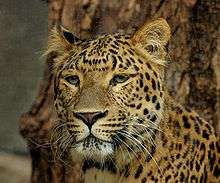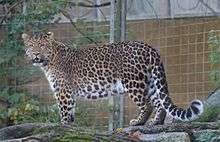North-Chinese leopard
| North-Chinese Leopard | |
|---|---|
.jpg) | |
| A North-Chinese leopard at Ménagerie du Jardin des Plantes, France. | |
| Scientific classification | |
| Kingdom: | Animalia |
| Phylum: | Chordata |
| Class: | Mammalia |
| Order: | Carnivora |
| Family: | Felidae |
| Genus: | Panthera |
| Species: | P. pardus |
| Subspecies: | P. p. japonensis |
| Trinomial name | |
| Panthera pardus japonensis (Gray, 1862) | |
| Synonyms | |
|
P. p. chinensis | |
The North-Chinese leopard (Panthera pardus japonensis), also known as North China leopard, is a leopard subspecies native to northern China. Population data are not available from the wild.[2]
Characteristics

The North-Chinese leopard was first described on the basis of a single tanned skin, which was fulvous above and pale beneath with large roundish, oblong black spots on the back and limbs, and small black spots on the head. The spots on the back, shoulders and sides formed a ring around a central fulvous spot. The black spots on the nape were elongated, and large ones on the chest formed a necklace. The tail was spotted and had four black rings at the tip.[3]
It is similar in size to the Amur leopard, however their coats are darker almost orange in color. The rosettes are also darker, smaller and closer together with the possibility of spots being within the rosettes - a trait more often familiar with jaguars rather than leopards. Their fur is also relatively long when compared to other leopard subspecies. The average weight in the wild is 50 kg (110 lb) for adult males and 32 kg (71 lb) for females.
Distribution and habitat
Historic records from before 1930 indicate that North-Chinese leopards lived near Beijing and in the mountains to the north-west. They possibly ranged up to the southern Ussuri region.[4] It was previously estimated that about 2,500 North-Chinese leopards remain in the wild of China. As of today, only small and isolated populations remain.[5] They also lived in Lanzhou in Northwest China, north to the mountains at the southern region of the Chinese Gobi Desert in Inner Mongolia, and near Harbin in the northeast.
Ecology and behavior
The North-Chinese leopard mates in January and February and after a gestation period of 105–110 days two to three young are born. The cubs weigh about one pound at birth, and open their eyes when they are about 10 days old. They will stay with their mother until they are about 20–24 months old.
Its prey base consists of deer and wild boar.
The North-Chinese leopard is solitary except for mating pairs and females with cubs. Adult males and females usually maintain territories.
Threats
The North-Chinese leopard is threatened by poaching, habitat loss, deforestation and mostly by the illegal trade for leopard skins.[2]
Conservation status
The Chinese leopards are included on CITES Appendix I. The leopards need better protection from illegal trade in skins and bones.[2]
In captivity

About 100 North-Chinese leopards are kept in zoos worldwide, with the vast majority in Europe. One male, known as Cheung Chi was responsible for siring over fifteen cubs up to 1988. Now he has over 40 descendants, leading to problems with maintaining genetic diversity. There is a European Endangered Species Program for this leopard for which roughly 60 individuals are participating. There are 11 North-Chinese leopards in Taiyuan Zoo (太原动物园) until 2014, Shanxi province in North-China.
Taxonomic history
Between 1867 and 1907, different authors described leopards from China using the scientific names Felis chinensis, bedfordi, fontanierii, grayi, and Panthera hanensis.[1][6]
See also
References
- 1 2 Wozencraft, W.C. (2005). "Panthera pardus japonensis". In Wilson, D.E.; Reeder, D.M. Mammal Species of the World: A Taxonomic and Geographic Reference (3rd ed.). Johns Hopkins University Press. p. 547. ISBN 978-0-8018-8221-0. OCLC 62265494.
- 1 2 3 Stein, A.B.; Athreya, V.; Gerngross, P.; Balme, G.; Henschel, P.; Karanth, U.; Miquelle, D.; Rostro, S.; Kamler, J.F.; Laguardia, A. (2016). "Panthera pardus". IUCN Red List of Threatened Species. Version 2016.2. International Union for Conservation of Nature.
- ↑ Gray, J. E. (1862). Description of some new species of Mammalia. Proceedings of the Scientific Meetings of the Zoological Society of London for the Year 1862: 262.
- ↑ Ellerman, J.R. and T.C.S. Morrison-Scott. (1966). Checklist of Palaearctic and Indian mammals 1758 to 1946. Second edition. British Museum (Natural History), London.
- ↑ Dou, H., Feng, L., Xiao, W., & Wang, T. (2014). In recent years there is an estimation form relevant bureau in Shanxi Province(China), which tells us there are at leaet 400 North-Chinese leopards in the wild there. The complete mitochondrial genome of the North Chinese Leopard (Panthera pardus japonensis). Mitochondrial DNA: 1-2.
- ↑ Stein, A. B.; Hayssen, V. (2010). "Panthera pardus (Carnivora: Felidae)" (PDF). Mammalian Species. 45 (900): 30–48. doi:10.1644/900.1.